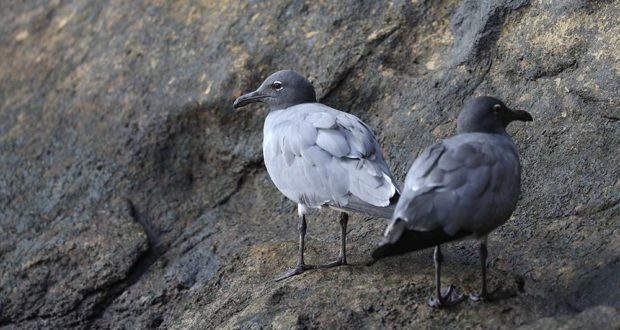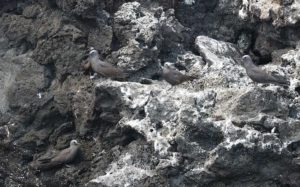With the exception of a wren with a fine yellow breast, and of a tyrant fly-catcher, none of the birds are brilliantly colored… All of the plants have a wretched, weedy appearance, and I did not see one beautiful flower. The insects, again, are small sized and dull-colored …
Charles Darwin, 8 October 1835
In the Galapagos, black is always fashionable. Especially if you want to stride inconspicuously over basaltic lava or perch in the barren Palo Santo along the shoreline. So it’s not surprising that a number of the islands’ endemic birds come in shades of gray.
- Lava Gulls (Larus fulginosus) are a sooty color from head to tail. The only thing that betrays them against the dark rocks are their thin, white eyelids. They are primarily scavengers but will feed on small lizards, fish and crustaceans. About 400 pairs are spread across the Galapagos, making them perhaps the rarest gull in the world. A small group perched on the rocks at the edge of the olivine beach at Punta Pitt one morning, while a solitary bird rested calmly on the lava near Mantlecito Beach.
- The Lava Heron (Butorides sundevalli) is endemic to the Galapagos, while the resident Striated Heron (Butorides striatus) is common throughout South America. Both are similar in profile and behavior to the Green Heron (Butorides virescens) that is common along the Texas Coast, with its characteristic hunched profile, long dark bill, slow gait and habit of staring intently into the water waiting for small fish to swim too close. The Lava Heron has a slate gray plumage with greenish highlights, while the Striated Heron is more of a dark brown with white stripes on its breast and yellow lores. In practice, it is sometimes difficult to tell the difference because the juvenile Lava Heron is striated and both species exhibit a range of color that fades into the other’s. Some researchers have suggested, so far inconclusively, that the two may interbreed, producing intermediate hybrids. I came across both species foraging among the lava rocks of the intertidal zone. One at Punta Carola had teamed up to go fishing with a Great Blue Heron.
- The Brown Noddy (Anous stolidus galapagensis) is a small tern that despite its name varies from dark brown to almost black. It breeds in small colonies along the ledges of rocky cliffs close to the sea and feeds on small fish at the surface of the water. I first saw a group of about a dozen that were difficult to distinguish against the rock face near Cerro Brujo on San Cristobal. They flew deftly all along the cliffs, snatching small fish from the water. Another group was interspersed with Galapagos Shearwaters feeding off the coast of Espanola. And, finally, a solitary Noddy darted about in the shallows of the surf on Santa Cruz as I walked along the beach.


